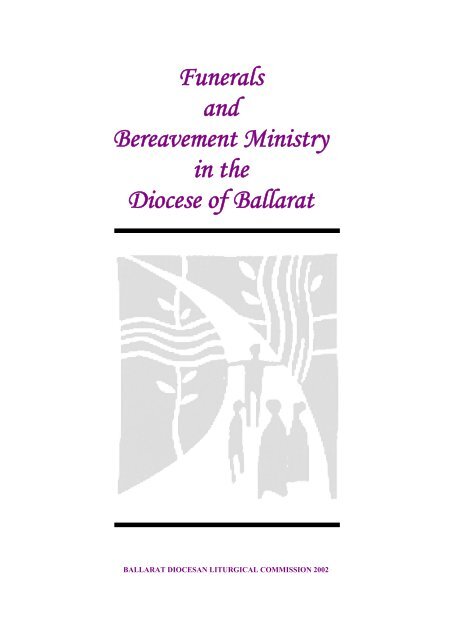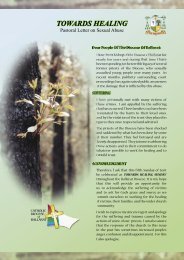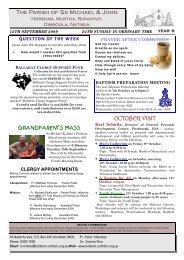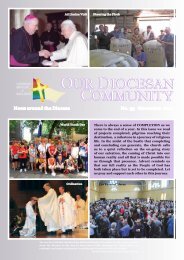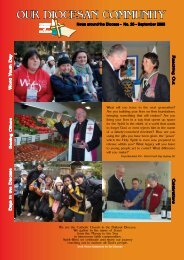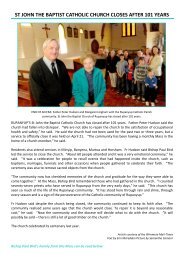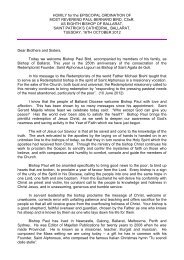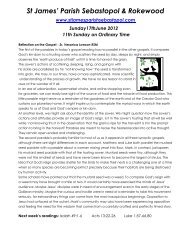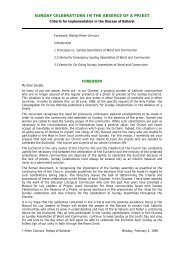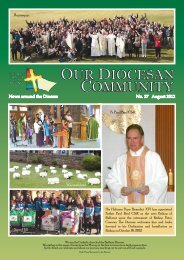Funeral Guidelines - Catholic Diocese of Ballarat
Funeral Guidelines - Catholic Diocese of Ballarat
Funeral Guidelines - Catholic Diocese of Ballarat
- No tags were found...
You also want an ePaper? Increase the reach of your titles
YUMPU automatically turns print PDFs into web optimized ePapers that Google loves.
Pastoral Letter to the People <strong>of</strong> the <strong>Diocese</strong> <strong>of</strong> <strong>Ballarat</strong>on the Sacrament <strong>of</strong> Anointing, Extreme Unctionand the Bereavement Ministry.My dear people,By now all <strong>of</strong> you are well aware that our <strong>Diocese</strong> is suffering a serious shortage <strong>of</strong> priests. You will be equallyaware that our <strong>Diocese</strong> is vast, covering in area about half <strong>of</strong> the state <strong>of</strong> Victoria. Many communities are now <strong>of</strong>tenrequired to celebrate the Lord’s Day with a layperson as the leader <strong>of</strong> the Assembly because the priests we havecan’t be everywhere; nor can they do everything. The manner in which many people have worked hard together toacquire the skills needed to organise, lead and even preach briefly at these Lay-led Assemblies speaks strongly <strong>of</strong>your determination to bring growth from this adversity. I am confident that you are not alone in this work: the HolySpirit is leading us and guiding us.DIOCESAN GUIDELINESThis letter accompanies <strong>Guidelines</strong> for <strong>Funeral</strong>s and the Bereavement Ministry in the <strong>Diocese</strong> <strong>of</strong> <strong>Ballarat</strong>, preparedby the Diocesan Liturgical Commission. I recommend them to you and ask that they become part <strong>of</strong> all preparationfor Vigil and <strong>Funeral</strong> celebrations. These guidelines are designed to assist with preparations when no priest isimmediately available to help a bereaved family prepare for the funeral <strong>of</strong> a loved one. Lay people in the localcommunity will be able to <strong>of</strong>fer this assistance - assistance with such matters as the possibility and procedures <strong>of</strong> aVigil, choosing the readings, the music and hymns, the petitions for the Prayer <strong>of</strong> the Faithful and other details forthe funeral service. This will make it possible for those preparing the <strong>Funeral</strong> to communicate with the Celebrant,even if he has to come from another parish to preside at the <strong>Funeral</strong>.I wish to thank all those generous people who are already exercising such roles in parishes, and further, to addressspecifically the spiritual needs <strong>of</strong> the dying. In this matter, I both seek your assistance and <strong>of</strong>fer you reassurance.SACRAMENTAL MINISTRY FOR THE DYINGPrior to the reforms <strong>of</strong> the Second Vatican Council, many people considered that the Sacrament for the dyingperson was the Sacrament <strong>of</strong> Extreme Unction. However, in more recent times it is more rightly known as theSacrament <strong>of</strong> the Anointing <strong>of</strong> the Sick. While this Sacrament can, <strong>of</strong> course be administered to the dying, it isnevertheless meant not for the dying, but for anyone suffering any serious illness. The letter <strong>of</strong> St. James instructedthe early Christians: “If one <strong>of</strong> you is ill he should send for the elders (priests) <strong>of</strong> the church, and they must anointhim with oil in the name <strong>of</strong> the Lord and pray over him. The prayer <strong>of</strong> faith will save the sick person and the Lordwill raise him up again; and if he has committed any sins he will be forgiven”. James 5:14-15The term “Anointing <strong>of</strong> the Sick” expresses far more adequately what this Sacrament is than did the term "ExtremeUnction". It may help you if I explain how the term Extreme Unction arose. It is a rather unfortunate translation <strong>of</strong>the Latin Extrema Unctio. The Latin term simply referred to the fact that this is the last <strong>of</strong> several anointings aChristian receives in the course <strong>of</strong> life. There are two anointings at Baptism, one before and one after the actualBaptism. The Sacrament <strong>of</strong> Confirmation is ministered through an anointing with Chrism. A man being ordained tothe ministerial priesthood receives an anointing <strong>of</strong> his hands during the Rite <strong>of</strong> Ordination. But the English termExtreme has been taken to imply that the closer to the moment <strong>of</strong> death this Sacrament is given the better. Indeed,the media <strong>of</strong>ten refers to it as the last Rites <strong>of</strong> the Church.2
“VIATICUM” – SACRAMENT FOR THE DYINGThe Church’s Sacrament for the dying is really Holy Communion. Given in the context <strong>of</strong> approaching death, HolyCommunion is described as Viaticum, which means Food for the Journey. After giving Communion, the ministeradds these words, “May the Lord Jesus Christ protect you and lead you to eternal life.” Along with Viaticum, theChurch has built up over the centuries a collection <strong>of</strong> beautiful Prayers for the Dying including, as death becomesimminent, prayers to commend the dying person to God.Given that the shortage <strong>of</strong> priests is becoming ever more acute, the presence <strong>of</strong> a priest at a deathbed is not alwaysrealistically possible. While it is very good if the dying person’s Parish Priest can be present to give Viaticum tothat person, the shortage <strong>of</strong> priests means that very <strong>of</strong>ten this will simply not be possible. However, there is noreason why the Eucharistic Ministers in a community, or even - if none be available - any well-disposed <strong>Catholic</strong>may minister Viaticum and lead the prayers for the dying and the commendation. Therefore I ask that in everyworshipping community, lay people be chosen to give Viaticum and lead the prayers I have spoken <strong>of</strong>.It may happen that the dying person will repeatedly ask for a priest. In such case, every reasonable effort should bemade to find a priest, for the dying person may have something troubling his or her conscience. Nevertheless, if nopriest is available, it is sufficient for the dying person to make a good Act <strong>of</strong> Contrition before receiving HolyCommunion. Pope John Paul II himself wrote this provision for persons unable to receive the Sacrament <strong>of</strong>Reconciliation but desiring to receive Holy Communion, into the new Code <strong>of</strong> Church Law, revised after theSecond Vatican Council. Remember that God’s will is for all to be saved.ANOINTING OF THE SICKAs Bishop <strong>of</strong> the <strong>Diocese</strong>, I am pleased to note that the Anointing <strong>of</strong> the Sick is celebrated regularly in manyplaces, both in Churches and in residences for our senior citizens. People should not receive this Sacrament forsomething as simple as a common cold with no complications. Nor should they present themselves for theAnointing merely because they wish to provide for all possible eventualities. It is a Sacrament for any illness thatcan be called serious. This seriousness may depend upon various factors, e.g. advancing years. A flu that is nothreat to a young person may be a serious threat to an elderly person. There is no need to be scrupulous in thismatter. The Anointing <strong>of</strong> the Sick is for anyone who has a serious illness, whether that illness be physical orpsychological, or an illness such as depression, which may be a combination <strong>of</strong> both. The sick are invited to receivethis Sacrament regularly. It is a serious misunderstanding to postpone receiving the Anointing till one hears theangel <strong>of</strong> death beckoning. Fortunately most <strong>of</strong> you now know and value the regular reception <strong>of</strong> the Anointing <strong>of</strong>the Sick.IN CONCLUSIONFinally I thank all <strong>of</strong> you who voluntarily assist the sick, the dying and the bereaved. There is a wonderful traditionin rural dioceses such as our own <strong>of</strong> supporting the bereaved. My prayer is that it will not fail in the years to come.I also wish to recognise those who unobtrusively continue to support the bereaved when the funeral is long overand relatives and friends have all gone about their daily business.Yours sincerely in Christ,Bishop <strong>of</strong> <strong>Ballarat</strong>June 24, 20023
<strong>Funeral</strong>s and the Bereavement Ministryin the <strong>Diocese</strong> <strong>of</strong> <strong>Ballarat</strong>At the death <strong>of</strong> a Christian, whose life <strong>of</strong> faith was begun in the waters <strong>of</strong> baptism andstrengthened at the eucharistic table, the Church intercedes on behalf <strong>of</strong> the deceased because <strong>of</strong>its confident belief that death is not the end nor does it break the bonds forged in life. The Churchalso ministers to the sorrowing and consoles them in the funeral rites with the comforting word <strong>of</strong>God and the sacrament <strong>of</strong> the Eucharist. Order <strong>of</strong> Christian <strong>Funeral</strong>s # 4.The funeral rites should be celebrated in an atmosphere <strong>of</strong> simple beauty, in a setting thatencourages participation. Order <strong>of</strong> Christian <strong>Funeral</strong>s # 21INTRODUCTIONThe time <strong>of</strong> death and burial in a community calls for a liturgical and pastoral response on the part <strong>of</strong> all inthe parish. The Order <strong>of</strong> Christian <strong>Funeral</strong>s provides the foundation for the response <strong>of</strong> the parishcommunity. The availability <strong>of</strong> clergy throughout the <strong>Diocese</strong> for this important work <strong>of</strong> ministering to thebereaved and assisting with the preparation <strong>of</strong> the funeral liturgies is becoming less and the responsibility isincreasingly that <strong>of</strong> the laity. In this time <strong>of</strong> change, the <strong>Diocese</strong> considers it important to provide commonprinciples and guidelines for the assistance <strong>of</strong> all who minister to the bereaved and the liturgical celebration<strong>of</strong> vigils and funerals.RECOMMENDATIONS TO PARISHES AND COMMUNITIES OF THE DIOCESEREGARDING FUNERALS AND THE BEREAVEMENT MINISTRY1. That parishes ensure there is a contact person or persons known to the parish andfuneral directors for the organization <strong>of</strong> all pertaining to the death <strong>of</strong> a parish member.2. That parishes develop Bereavement groups. Such groups would be a parish presencefor grieving parishioners, assist with preparation <strong>of</strong> Vigil prayers and the <strong>Funeral</strong>liturgy and provide on-going care support for the bereaved as needed.3. That Bereavement Teams become familiar with the Order for Christian <strong>Funeral</strong>s andundertake appropriate formation for their role.4. That all parishes strive to observe the guidelines presented here for the liturgicalcelebrations <strong>of</strong> Vigils and <strong>Funeral</strong>s.LITURGICAL GUIDELINESFOR THE DEATH AND BURIAL OF A CHRISTIANPASTORAL CARE AT THE TIME OF DYING AND DEATHA parish response should be made at the time <strong>of</strong> dying and death. If a priest is not available, the parish leader ormember <strong>of</strong> the bereavement team should be available to be present in an appropriate way with the dying personand the family. They should be provided with the necessary resources and procedures to give communion to thedying (Viaticum) and prepared to provide formal prayers for the dying or a brief blessing and words <strong>of</strong> comfort.Sacramental care <strong>of</strong> the sick and dying takes place through the rites <strong>of</strong> Anointing and Viaticum. The Sacrament<strong>of</strong> Anointing is the sacrament for the sick and Viaticum, reception <strong>of</strong> Communion when in danger <strong>of</strong> death, isfor the dying.4
LITURGICAL CELEBRATIONSThe liturgical celebrations for the death <strong>of</strong> a Christian are the Vigil and the <strong>Funeral</strong>. In the initial contact withthe family for the planning <strong>of</strong> the liturgies, all options regarding Vigils and funerals should be made availablefor the family to consider.A. VIGILSThe Order <strong>of</strong> Christian <strong>Funeral</strong>s sees the Vigil as the first formal gathering <strong>of</strong> the community in prayer andremembrance <strong>of</strong> the one who has died and in support <strong>of</strong> the bereaved1. Place <strong>of</strong> Vigil The vigil can be in the home, funeral parlour, church. Constraints <strong>of</strong> cost, distance mayrequire careful planning.2. Length <strong>of</strong> Liturgy. The Vigil liturgy should be <strong>of</strong> a suitable length to allow for appropriate prayersand sharing <strong>of</strong> memories, but not be excessively long to be <strong>of</strong> a burden to people.3. Leadership <strong>of</strong> the Liturgy The Order <strong>of</strong> Christian <strong>Funeral</strong>s sees the Vigil as a time <strong>of</strong> lay liturgicalleadership and therefore accessible to all despite the unavailability <strong>of</strong> an ordained minister. Those whoare to lead the vigil liturgy should receive appropriate formation.4. Plan <strong>of</strong> Liturgy. The purpose <strong>of</strong> the Vigil is to be present with the one who has died, to recall andshare the person’s life and to hear the message <strong>of</strong> the Gospel in regard to the death <strong>of</strong> a Christian.Therefore the form <strong>of</strong> the Liturgy should be one which the bereaved can take part in. The Liturgyshould allow for:• the Proclamation <strong>of</strong> the Word,• prayer for the living and the dead,• sharing <strong>of</strong> the symbols and memories <strong>of</strong> the person’s life.Comment re Presence <strong>of</strong> the Body: While the Vigil is seen as gathering in the presence <strong>of</strong> the body,distance and cost may be a factor in realising this. However, the presence <strong>of</strong> the body in the Churchovernight, between vigil and funeral should be carefully considered as a way <strong>of</strong> overcoming thesedifficulties. If there is a viewing <strong>of</strong> the body in the funeral home, this can be an opportunity for prayer.Comment re Vigil without the Body present: If the body is not present for the Vigil, where possible,use some <strong>of</strong> the Christian symbols, e.g. Paschal candle, to link the Vigil to the <strong>Funeral</strong> and burial.Comment re. the Rosary: While for many years the practice <strong>of</strong> saying the Rosary has been the form <strong>of</strong>Vigil practised in the <strong>Diocese</strong>, increasingly it is not a practice that has meaning for the bereaved. Thoseplanning the liturgies should be sensitive to the appropriateness or otherwise <strong>of</strong> the Rosary for a form <strong>of</strong>Vigil prayer. It is recommended that if the Rosary is to be prayed, it be incorporated into a simpleliturgy with scripture.Comment re a Vigil Mass: Care must be taken to ensure that the essential nature <strong>of</strong> the Vigilgathering is observed. If a Vigil is to be celebrated with Mass, it should be distinct from the funeral inreadings, homily and use <strong>of</strong> symbols. The vigil is not a funeral for those who cannot attend the funeral.B. LITURGICAL GUIDELINES FOR THE CELEBRATION OF FUNERAL MASSES AND SERVICES<strong>Funeral</strong>s can be celebrated in a number <strong>of</strong> places – the Church, <strong>Funeral</strong> Parlour, Graveside, Crematorium. Ineach case, there should be appropriate use <strong>of</strong> Christian symbols and Scripture for the funeral service andcommittal. <strong>of</strong> the body and/or ashes. Those preparing for funerals should ensure that the necessarypreparations are made and communicate with the funeral director re all liturgical celebrations.1. Length <strong>of</strong> Liturgy. The length <strong>of</strong> the <strong>Funeral</strong> celebration should take into consideration thetension for the bereaved, the constraints <strong>of</strong> those attending, the requirements regarding the use <strong>of</strong>the church or place <strong>of</strong> celebration and cemetery. In the normal course <strong>of</strong> events, <strong>Funeral</strong> Massesshould aim to be no longer than one hour.2. Eulogy. Placement <strong>of</strong> the Eulogy is at the beginning <strong>of</strong> Mass or Service, after the Greeting. Length<strong>of</strong> the Eulogy is to be no more than 7 minutes. It is recommended that only one person gives theEulogy and that the text <strong>of</strong> the Eulogy is written out.5
3. Symbols. Symbols are <strong>of</strong> two kinds: Life symbols and Sacred/Christian symbols.• Life symbols. Provision should be made for life symbols (photos, fishing rods, knitting….) tobe placed in an appropriate and dignified place at the front <strong>of</strong> the Church prior to the<strong>Funeral</strong> liturgy, separate from the Christian symbols. The life symbols could be alluded toduring the Eulogy.• Sacred/Christian symbols. The symbols <strong>of</strong> paschal candle, pall, water, incense, devotionalarticles should be used according to the ritual. The pall can appropriately remain on thec<strong>of</strong>fin until reaching the graveside. Only Christian symbols should be placed on the c<strong>of</strong>fin.Flowers for the c<strong>of</strong>fin should be moderate in size.4. Readings. Readings for the Liturgy <strong>of</strong> the Word are to be from Sacred Scripture and an authorisedtranslation used. Other readings may be included during the Eulogy or after Communion at a<strong>Funeral</strong> Mass.5. Presentation <strong>of</strong> the Gifts. Only the bread and wine should be presented at this time in a <strong>Funeral</strong>Mass.6. Music. Music during the <strong>Funeral</strong> Mass should be sacred music and liturgically appropriate. Musicduring a <strong>Funeral</strong> Service should be appropriate for the ritual being celebrated. Requested musicmay be incorporated in a reflective manner and the music as the c<strong>of</strong>fin leaves the church could benegotiable. Consideration re use <strong>of</strong> personal choice music may also be part <strong>of</strong> the gathering after the<strong>Funeral</strong>.C. THE RITE OF COMMITTALThe Rite <strong>of</strong> Committal may take place at the Graveside or at the Crematorium. If there is to be no service atthe graveside or Crematorium, it is appropriate to have a simple ritual <strong>of</strong> farewell as the hearse leaves theChurch. It is also appropriate to have a simple prayer service for the Committal <strong>of</strong> Ashes.D. AFTER THE FUNERALFollowing the immediate time <strong>of</strong> the funeral, continuing pastoral support should be <strong>of</strong>fered to the bereaved,e.g. regular visits, a card or some kind <strong>of</strong> remembrance on the first anniversary <strong>of</strong> death. Occasions <strong>of</strong>liturgical celebration for those who have died should feature in the life <strong>of</strong> the parish, e.g. the inclusion <strong>of</strong>prayers for those who have died in the General Intercessions, an annual memorial Mass or service, prayersduring November, Mass in the cemetery.LOOKING TO THE FUTUREThe <strong>Diocese</strong> recognises that it is entirely possible that in the future, there will be occasions when a priest cannotbe contacted regarding the funeral <strong>of</strong> someone who has died in a parish community. Lay leaders <strong>of</strong> <strong>Funeral</strong>swill have to be authorised for this eventuality and the diocese is moving to establish this. At the present time, ifthis situation does arise, parish communities are asked to observe the following procedure.1. Endeavour to make contact with a Priest or Parish Leader <strong>of</strong> neighbouring parishes in your Regional<strong>Catholic</strong> community.2. In the event that no help is available from the Regional <strong>Catholic</strong> community, contact either the Bishop’sOffice (ph: 5337 7121) or the Diocesan Pastoral Ministry Office (ph: 5337 7159) for assistance.3. Ensure that each parish community has an appointed contact person in regard to death, funerals andburials.LOCAL PARISH INFORMATIONIn the case <strong>of</strong> a death in the Parish, contact the following:6


